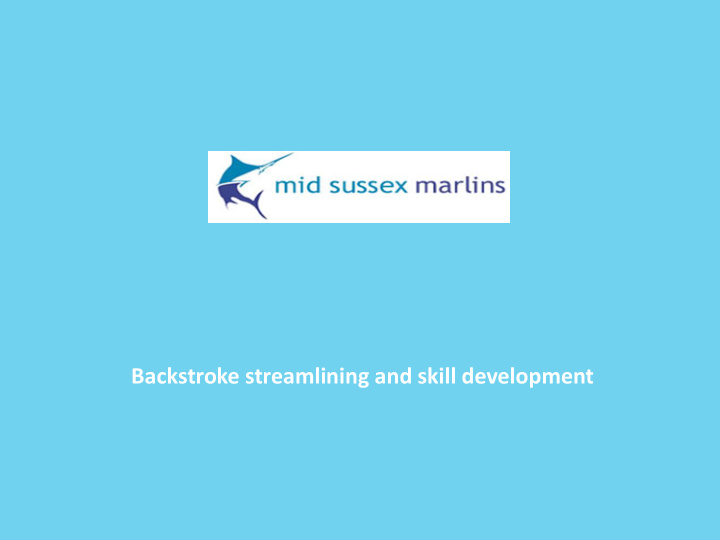



Backstroke streamlining and skill development
Streamlining The simplest way to improve swimming speed is to improve the streamline of the head and body
• Poor skills in starting/turning/transfer to stroke will put you at a disadvantage to other swimmers in the race who have superior skills. • The older you become improvements become minimal, superior streamlining skills and transfer to stroke ability off starts and turns, should be addressed early in the training programme. • Technique is the number 1 avenue for improvement!
• It is difficult for humans to progress through water because they incur resistance, which causes a swimmer to slow down. • Reduce resistance caused by the head and body and the swimmer will go faster when seeking speed or go further each stroke when attempting to swim long distances.
• Most Olympic Champions swim with less strokes than their competitors (improve streamline improve stroke length) • Most are more streamlined within the actual swimming stroke for longer • Better streamline = less frontal drag • Poor streamline = increased frontal drag
Perfect streamline Teach streamline focus on tension through Joints • Ankles - Knees – hips • Shoulders - Neck • Elbows - Wrist • Apply strength in these areas • Maintain flexibility Your turn……………………
Essential technical points • • Stroke Length/DPS Body / head Position • • Stroke Rate Breathing • • Acceleration Body roll (Hip shoulders) • • Rotation Entry / re position / catch • • Rhythm Pulling phase • • Consistency of application Recovery phase • • Flexibility and ROM Kicking • Overall efficiency Newtons 3 rd law – for every action there is an equal and opposite reaction…………………..
Backstroke key technical points • The nature of the stroke demands that balance ,rhythm, relaxation and controlled rotation are key to good technique. • Timing of rotation is important to keep the stroke flowing and maintain balance • Build a strong core strength to maximise underwater skill off the wall • Important to hold SR throughout the race, this is a common fault particularly when swimming 200 BK • Have the ability to maximise underwater transition from the start and turns, accelerate into first stroke at the surface. • Rate of underwater kick is crucial to maintain momentum and speed off the wall • Important to maximise u/w kick in sets (don’t ignore or be lazy off walls)
Backstroke body and head position: Reducing resistance • The posture of the swimmer should embrace being flat along the surface (good posture in water). • Head held back and aligned with the horizontal axis with the eyes looking directly up at the ceiling of the pool. • Keep the head still and stable (no movement). • Body position should be firm along a horizontal axis in the water • Some part of the hip should be visible through out the stroke: If hips are too low more resistance is encountered = slower swimming.
Streamlined Backstroke position
Backstroke body roll: Reducing resistance, increasing efficiency • Body roll consists of the hips and shoulders rotating to ~45° to both sides. That reduces frontal resistance and positions the pulling arm closer to the mid-line. • The harder a swimmer kicks, the greater is the amount of resistance developed. Kicking should remain small and fast and deviate to each side in concert with the roll of the shoulders/hips. • Backstrokers should emphasize body roll by performing a vertical recovery that lifts the shoulder / facilitates the roll. • Do not move the head with the body roll
Hip at surface / kick shallow and fast
Backstroke key technical points • Slight incline in body position acceptable to accommodate head position. • A high head = lower hips = more resistance. • Fixed head position throughout stroke cycle. • Rotation of body through hips and shoulders • Early flexed elbow in pull, accelerate continually through pull phase • Hand finishes below body line. • Thumb first recovery on exit, turning to lead / entry with back of hand (slightly rotted hand acceptable) • Continuous kick from hips • Slight in-toeing of feet • Propulsion on up-kick
Recommend
More recommend